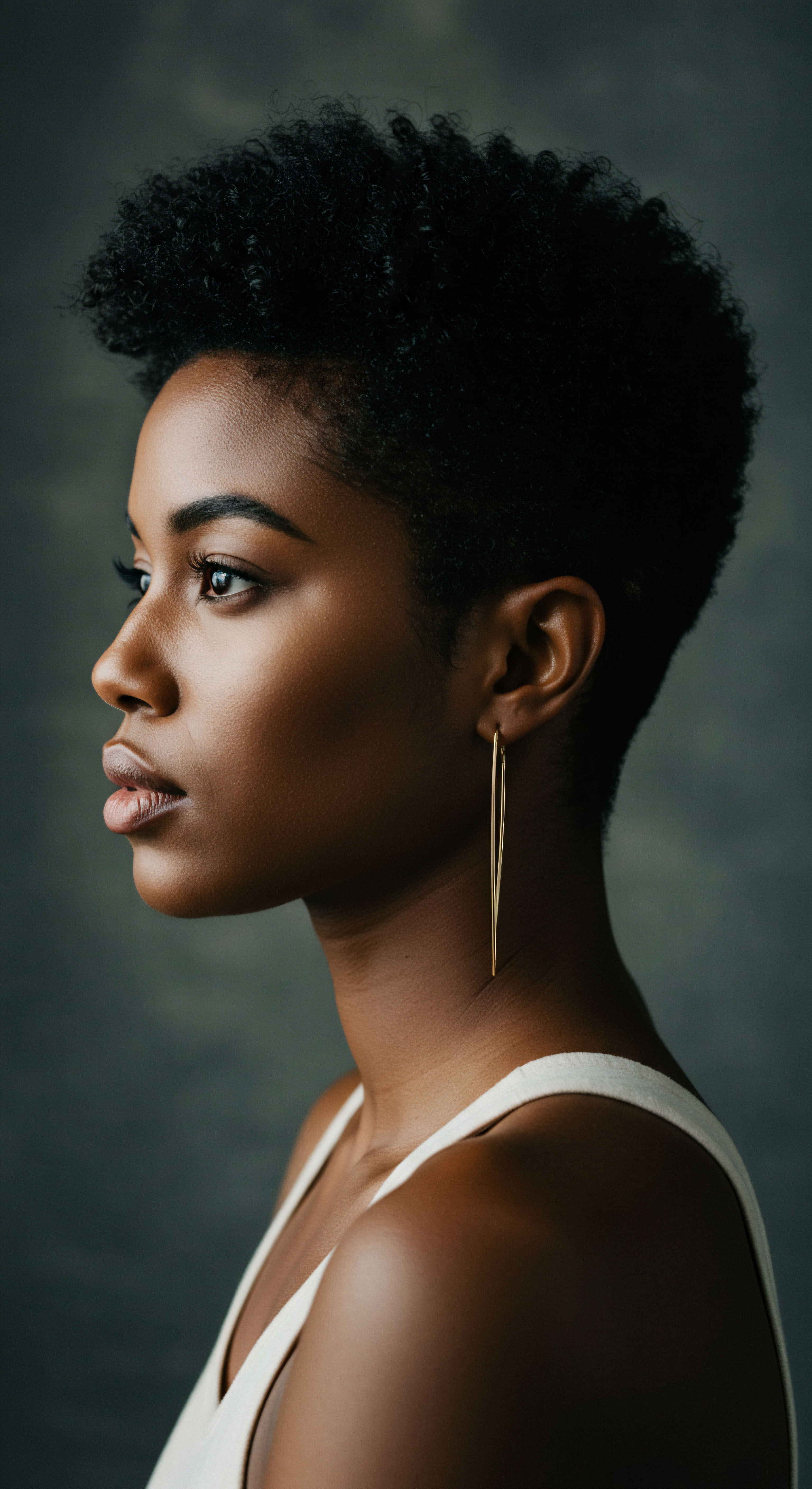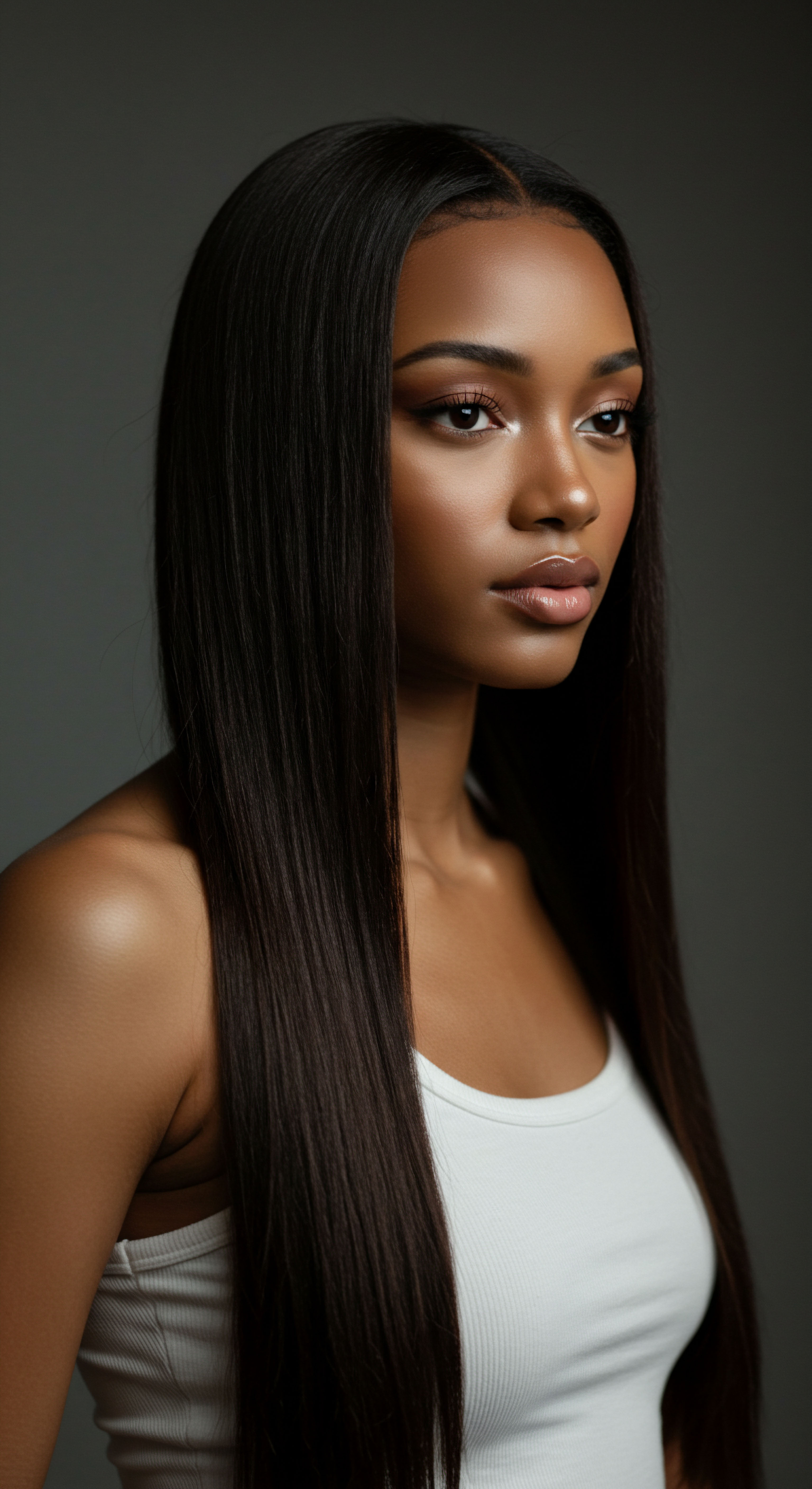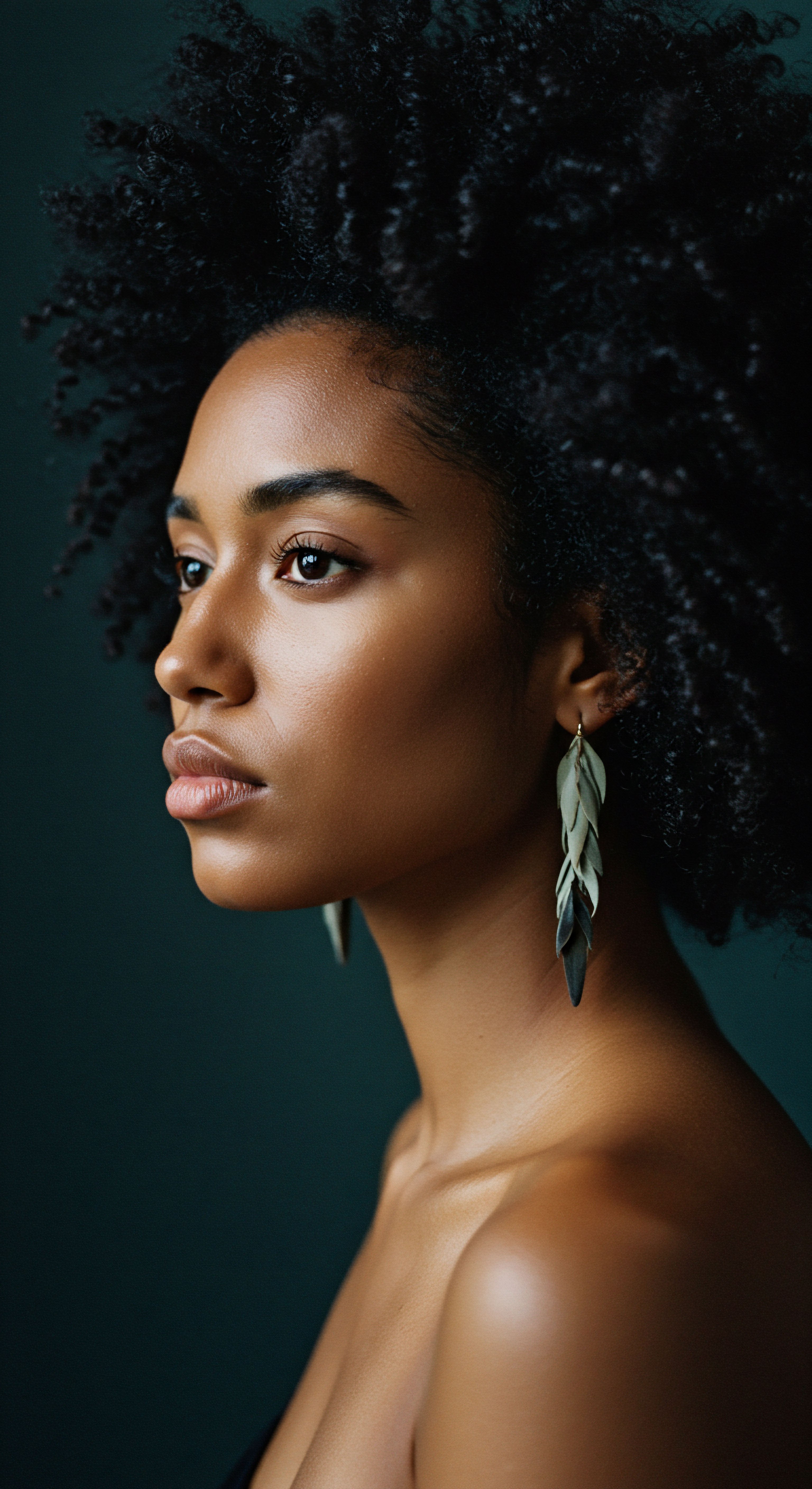
Roots
The whisper of silk against coils, the gentle embrace of cotton around twists—these quiet gestures hold stories far older than memory, stretching back to the dawn of time when humanity first began to adorn, protect, and signify through their crowns. For textured hair, in its glorious spectrum of curls, kinks, and waves, a covering has never simply been a piece of fabric. It has served as a silent lexicon, a visual chronicle, speaking volumes about identity, status, spirituality, and survival. To truly understand this profound connection, we must first look to the very essence of textured hair itself, its unique architecture, and the ancestral wisdom that recognized its vulnerability and vitality.
Consider the distinct morphology of textured hair, a marvel of biological artistry. Unlike straight strands, which often possess a circular cross-section, textured hair exhibits an elliptical or even flattened shape. This unique structure, coupled with the way the hair shaft spirals from the follicle, creates its characteristic curl pattern. The bends and turns along each strand mean that natural oils, or sebum, produced by the scalp, travel with greater difficulty down the hair shaft.
This inherent characteristic often renders textured hair more prone to dryness, making it susceptible to breakage if not carefully tended. This delicate balance of structure and moisture, passed down through generations, shaped early practices of hair care and protection.
Hair coverings for textured strands represent an ancient, evolving language of identity, protection, and reverence.

Understanding the Hair’s Intricate Structure
The very cuticle layer, the outermost protective sheath of the hair, also behaves differently on textured strands. These scales, which lie flat on straight hair, tend to be more raised on curly and coily hair, further contributing to moisture loss and potential snagging. This microscopic reality underscores the historical imperative for protective measures.
Our ancestors, perhaps without microscopes but with generations of keen observation, understood this need for safeguarding. They recognized that the elements—the harsh sun, the biting wind, the dust of daily life—could diminish the hair’s inherent moisture and strength.
- Hair Anatomy ❉ Textured hair typically features an elliptical or flat cross-section, contrasting with the rounder shape of straight hair.
- Cuticle Behavior ❉ The cuticle scales on textured hair often lift slightly, which can affect moisture retention and susceptibility to tangling.
- Sebum Distribution ❉ Natural oils from the scalp find it more challenging to traverse the bends and curves of textured hair, leading to increased dryness.

Early Protective Practices and Cultural Classifications
Long before commercial products, hair coverings served as an intuitive, accessible shield. They preserved moisture, shielded from environmental aggressors, and minimized friction that could lead to breakage. This pragmatic function, however, quickly transcended mere utility, intertwining with social stratification, spiritual conviction, and artistic expression.
In many ancient African societies, hair itself was a living sculpture, a testament to one’s lineage, marital status, age, and even profession. Elaborate styles, often requiring hours of communal effort, were not simply aesthetic choices; they were declarations.
Hair coverings, then, became extensions of these declarations, sometimes signifying modesty, other times royalty, mourning, or celebration. A woman’s headwrap might denote her wealth through the quality of the fabric, her marital status through its particular fold, or her spiritual devotion through its symbolic colors. The practices varied widely across continents and communities, yet a shared thread of reverence for the hair, and the covering as its guardian, remained.
| Region or Culture West Africa (e.g. Yoruba) |
| Common Covering Materials Aso Oke, cotton, silk |
| Symbolic Associations Status, celebration, spiritual protection, beauty |
| Region or Culture Ancient Egypt |
| Common Covering Materials Linen, wigs (often covered) |
| Symbolic Associations Hygiene, status, protection from sun, religious practice |
| Region or Culture Southern Africa (e.g. Zulu) |
| Common Covering Materials Beaded fabrics, animal skins |
| Symbolic Associations Marital status, age, community identity |
| Region or Culture Early African Diaspora |
| Common Covering Materials Cotton, scraps, reclaimed fabrics |
| Symbolic Associations Modesty, resistance, forced regulation, identity preservation |
| Region or Culture Hair coverings held diverse yet consistently deep meanings across historical and cultural landscapes. |
The deep understanding of textured hair’s physical properties, coupled with a societal recognition of its profound communicative power, laid the groundwork for hair coverings to ascend beyond simple adornment. They became, and remain, a fundamental aspect of cultural identity, a tangible link to ancestral practices, and a silent, yet potent, statement about the wearer’s place in the world.

Ritual
As we move from the foundational understanding of textured hair’s intrinsic nature, our attention turns to the daily and periodic practices that shape its vitality. Here, the concept of hair covering transcends mere historical artifact and steps into the vibrant rhythm of contemporary life, transforming into a deeply personal ritual. It is in these moments of conscious choice—the selection of a silk scarf for the night, the artful tying of a headwrap for the day—that the past truly breathes within the present. This section explores how hair coverings serve not only as practical tools but as sacred components of a holistic hair care regimen, fostering health, beauty, and a quiet sense of personal agency.
The practice of covering textured hair, particularly during sleep, stands as a cornerstone of protective styling. The delicate nature of coils and curls, prone to friction and moisture loss against absorbent pillowcases, finds sanctuary beneath the smooth glide of silk or satin. This nightly ritual guards against tangles, minimizes breakage, and preserves the intricate styling efforts of the day, allowing the hair to retain its natural oils and moisture. It is a quiet act of self-preservation, a recognition of the hair’s needs, and a gentle investment in its long-term health.

The Nighttime Sanctuary Why Sleep Protection Matters
Consider the seemingly simple act of sleeping. For textured hair, a cotton pillowcase can act like a thirsty sponge, drawing precious moisture from the strands. The constant rubbing against rough fibers can also create frizz, disrupt curl patterns, and lead to micro-abrasions along the hair shaft, weakening it over time. This understanding gives rise to the widespread adoption of bonnets, scarves, and durags made from low-friction materials.
These nighttime coverings create a protective cocoon, allowing the hair to glide rather than snag, thereby preserving its integrity. This ritual extends beyond mere physical protection; it becomes a moment of conscious care, a pause in the day to honor and attend to the hair’s unique requirements. The selection of a bonnet, its softness against the scalp, becomes a small act of self-reverence, a daily affirmation of textured hair’s value.
Nighttime hair coverings transform sleep into a restorative period, safeguarding textured strands from friction and moisture depletion.

Styling and Definition Techniques
Beyond the quiet of the night, hair coverings also serve as versatile tools in the daytime styling repertoire. Headwraps, for instance, are not simply accessories; they are dynamic canvases that allow for endless artistic expression while simultaneously protecting the hair from environmental elements. A well-placed wrap can shield a fresh set of twists from humidity, protect braids from dust, or simply offer a respite for strands needing a break from manipulation.
The skill involved in tying a headwrap, often passed down through generations, represents a practical art form. Each fold, each knot, speaks to a history of resourcefulness and creativity. This practical application of coverings demonstrates their ongoing relevance in daily textured hair management, offering both style and substance.
- Preservation of Style ❉ Hair coverings maintain the integrity of braids, twists, and other protective styles, extending their longevity.
- Moisture Retention ❉ They help seal in moisture from styling products, particularly in dry or harsh climates.
- Frizz Control ❉ By reducing exposure to humidity and friction, coverings aid in minimizing frizz and maintaining curl definition.

Wigs Hair Extensions and the Art of Concealment
The world of wigs and hair extensions, while not always considered “coverings” in the traditional sense, often serves a similar protective function for textured hair. Wigs, particularly, allow the natural hair to rest, grow, and receive deep conditioning treatments undisturbed. They provide a barrier against manipulation and styling tools that could otherwise cause stress. This form of covering offers versatility in appearance while prioritizing the health of the hair underneath.
The decision to wear a wig or extensions often stems from a desire for convenience, a shift in aesthetic, or a strategic move to allow one’s natural hair to flourish in a protected state. This deliberate choice underscores a nuanced approach to hair care, where the “covering” facilitates a journey toward greater hair health and personal expression. The ritual of wig application, or the meticulous installation of extensions, becomes another layer in the complex relationship between textured hair and its adornments.

Relay
Stepping beyond the immediate practicalities and personal rituals, we now consider the profound, often unspoken, messages hair coverings have relayed across generations for textured hair. This is where history, societal pressure, and individual agency intertwine, creating a complex narrative that extends far beyond mere aesthetics. What hidden dialogues have these seemingly simple fabrics conducted throughout time, and how do they continue to speak to the experience of textured hair in a world still grappling with its innate beauty?
The significance of hair coverings for textured hair is not merely a tale of adornment or protection; it is a profound commentary on power, resistance, and identity. Throughout history, hair has been a potent symbol, and for Black individuals, its visibility and styling have often been subject to external scrutiny and control. This scrutiny, at times, led to legislative efforts to suppress the visual expression of textured hair, thereby imbuing hair coverings with a complex, layered meaning.

The Tignon Laws A Historical Mandate
A particularly stark example of this historical control is the Tignon Laws, enacted in colonial Louisiana in 1786. These laws mandated that free women of color wear a tignon, a type of head covering, to suppress their elaborate hairstyles and perceived attractiveness. The intent was clear ❉ to visibly distinguish them from white women and to diminish their social standing in a racially stratified society. This legal imposition underscores how hair, and its covering, became a battleground for social control and racial hierarchy.
Yet, what began as an oppressive measure was often subverted. Women of color, with their enduring spirit, transformed the mandated tignon into a statement of defiance and personal artistry. They adorned their headwraps with jewels, feathers, and intricate folds, turning a symbol of subjugation into an expression of their resilience, creativity, and undeniable beauty.
This historical episode highlights a persistent theme ❉ while external forces may seek to define and confine, the human spirit, particularly within marginalized communities, often finds ways to reclaim and redefine symbols of oppression. The tignon, therefore, relayed not just compliance, but also quiet, powerful resistance.
Hair coverings for textured hair have often served as complex conduits, conveying both societal pressures and individual resilience.

Societal Perceptions and Psychological Impact
The echoes of such historical mandates reverberate into contemporary societal perceptions of textured hair. Even today, the way textured hair is presented, whether uncovered or covered, can influence how individuals are perceived in professional or academic settings. Research by Dove and LinkedIn in 2019 revealed that Black Women are 2.5 Times More Likely to Be Perceived as Unprofessional Because of Their Hair. While this statistic does not directly address hair coverings, it speaks to the underlying pressures that can lead individuals with textured hair to adopt protective styles, including headwraps, as a means of conforming to narrow beauty standards or avoiding discrimination.
This reality means that for some, a hair covering might be a strategic choice to navigate biases, a way to mitigate potential judgment in environments where natural textured hair is still unfairly stigmatized. This choice, however, carries its own weight, as it can be a silent acknowledgment of societal expectations rather than a purely autonomous aesthetic decision. The covering, in this context, relays a message about the ongoing struggle for acceptance and the quiet burden of navigating prejudiced spaces.

Cultural Preservation and Modern Expressions
Conversely, for many, the contemporary use of hair coverings is a deliberate act of cultural preservation and celebration. It is a conscious decision to connect with ancestral traditions, to honor heritage, and to assert identity in a world that often seeks to homogenize. Modern headwraps, turbans, and bonnets are worn with pride, not as a concession to external pressure, but as an affirmation of self. They become a visible sign of belonging, a nod to history, and a bold statement of beauty.
The relay of meaning here is one of reclamation and empowerment. The fabric becomes a canvas for self-expression, its colors and patterns telling a story of cultural richness and personal style. This shift from mandated covering to chosen adornment speaks volumes about the evolving relationship individuals with textured hair have with their crowns, transforming a historical burden into a source of contemporary strength and beauty.
| Historical Context Ancient African Traditions |
| Primary Meanings Conveyed Status, spirituality, protection, identity |
| Modern Interpretations Cultural pride, spiritual connection, stylistic choice |
| Historical Context Slavery and Post-Emancipation |
| Primary Meanings Conveyed Modesty, survival, forced compliance, subtle resistance |
| Modern Interpretations Reclamation, resilience, heritage celebration |
| Historical Context Tignon Laws Era |
| Primary Meanings Conveyed Subjugation, defiance, artistic subversion |
| Modern Interpretations Historical awareness, empowerment through style |
| Historical Context Contemporary Society |
| Primary Meanings Conveyed Protection, fashion, identity assertion, navigating bias |
| Modern Interpretations Self-care, personal expression, cultural continuity |
| Historical Context The significance of hair coverings has continuously transformed, reflecting societal shifts and individual agency. |
The ongoing dialogue between textured hair and its coverings is a vibrant testament to human adaptability and the enduring power of cultural expression. From the oppressive mandates of the past to the celebrated expressions of the present, these coverings continue to relay intricate messages about identity, resilience, and the ever-present beauty of textured hair.

Reflection
As we gently close this exploration, we are left with a deeper appreciation for the profound dialogue between textured hair and its coverings. These seemingly simple fabrics are far from mere accessories; they are living artifacts, vessels of memory, and canvases for self-expression. They speak of ancient wisdom, of quiet resistance, of daily acts of care, and of vibrant declarations of identity.
The story of hair coverings for textured hair is not a linear one, but a cyclical journey, where past burdens are transformed into present strengths, and where every fold and knot carries the weight of history and the promise of a flourishing future. It is a testament to the enduring spirit that finds beauty and meaning in every strand, and every protective embrace.

References
- Dove CROWN Research Study. (2019). The CROWN Act ❉ Creating a Respectful and Open World for Natural Hair.
- Grier, William H. & Cobbs, Price M. (1968). Black Rage. Basic Books.
- Byrd, Ayana D. & Tharps, Lori L. (2014). Hair Story ❉ Untangling the Roots of Black Hair in America. St. Martin’s Press.
- Mercer, Kobena. (1994). Welcome to the Jungle ❉ New Positions in Black Cultural Studies. Routledge.
- Banks, Ingrid. (2000). Hair Matters ❉ Beauty, Power, and the Politics of African American Women’s Hair. New York University Press.
- Craig, Maxine Leeds. (2002). Ain’t I a Beauty Queen? ❉ Black Women, Beauty, and the Politics of Race. Oxford University Press.
- White, Deborah Gray. (1999). Ar’n’t I a Woman? ❉ Female Slaves in the Plantation South. W. W. Norton & Company.